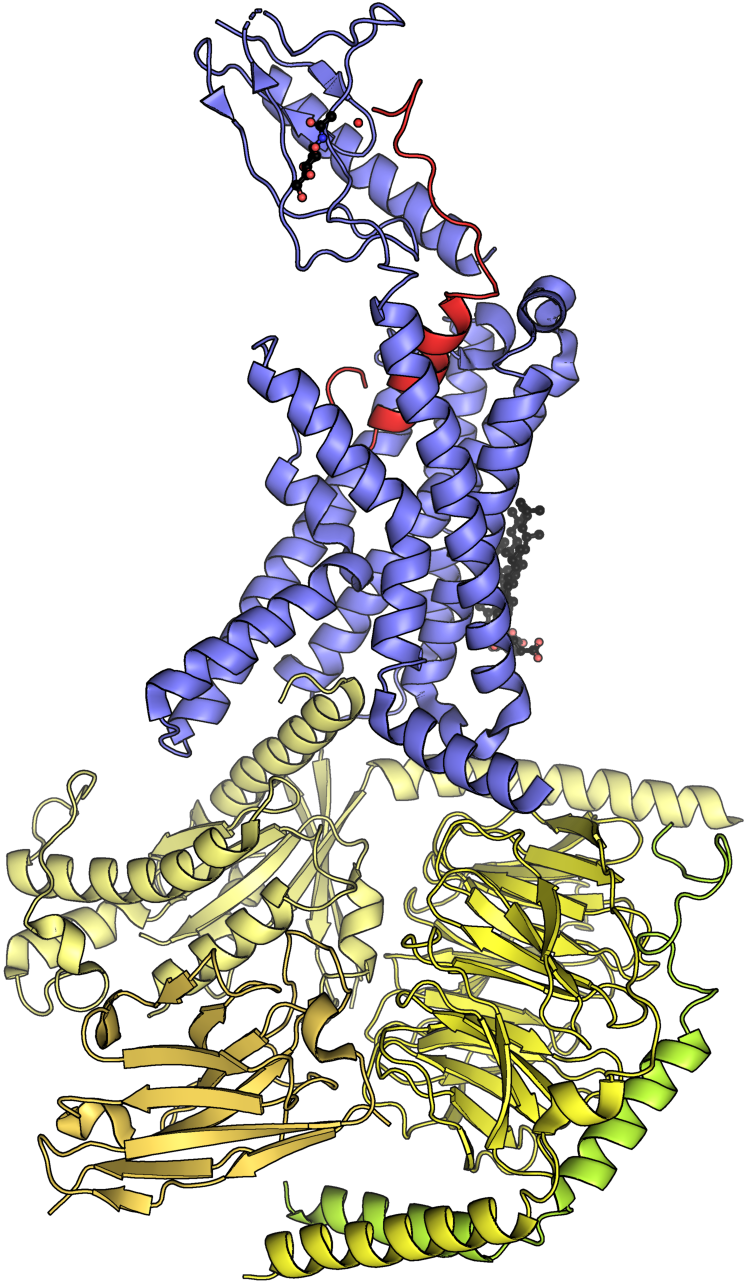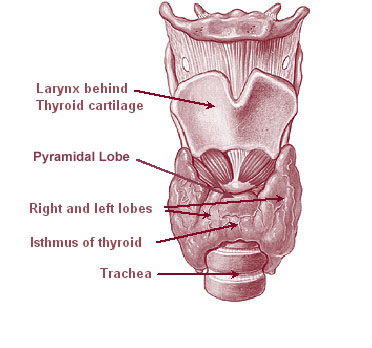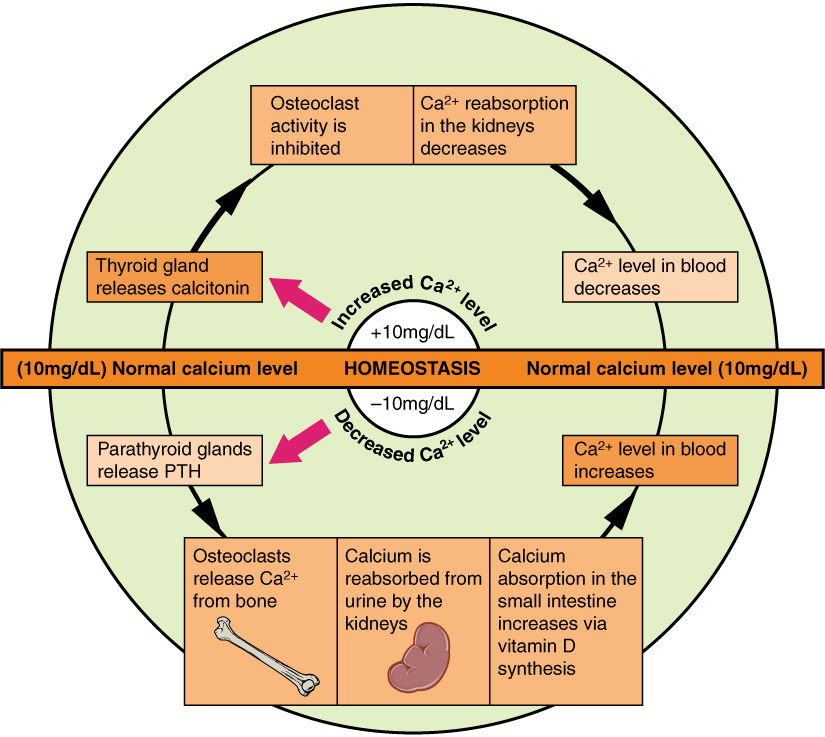|
Calcitonin
Calcitonin is a 32 amino acid peptide hormone secreted by parafollicular cells (also known as C cells) of the thyroid (or endostyle) in humans and other chordates in the ultimopharyngeal body. It acts to reduce blood calcium (Ca2+), opposing the effects of parathyroid hormone (PTH). Its importance in humans has not been as well established as its importance in other animals, as its function is usually not significant in the regulation of normal Calcium metabolism, calcium homeostasis. It belongs to the calcitonin-like protein family. Historically calcitonin has also been called thyrocalcitonin. Biosynthesis and regulation Calcitonin is formed by the proteolytic cleavage of a larger prepropeptide, which is the product of the CALC1 gene (). It is functionally an antagonist with PTH and Vitamin D3. The CALC1 gene belongs to a superfamily of related protein hormone precursors including islet amyloid precursor protein, calcitonin gene-related peptide, and the precursor of adrenomedul ... [...More Info...] [...Related Items...] OR: [Wikipedia] [Google] [Baidu] |
Calcitonin Gene-related Peptide
Calcitonin gene-related peptide (CGRP) is a neuropeptide that belongs to the calcitonin family. Human CGRP consists of two Protein isoform, isoforms, CGRP alpha (α-CGRP, also known as CGRP I) and CGRP beta (β-CGRP, also known as CGRP II). α-CGRP is a 37-amino acid neuropeptide formed by alternative splicing of the calcitonin/CGRP gene located on chromosome 11. β-CGRP is less studied. In humans, β-CGRP differs from α-CGRP by three amino acids and is encoded in a separate, nearby gene. The CGRP family includes calcitonin (CT), adrenomedullin (AM), and amylin (AMY). Function CGRP is produced in both peripheral and central neurons. It is a potent peptide vasodilator and can function in the transmission of nociception. In the spinal cord, the function and expression of CGRP may differ depending on the location of synthesis. CGRP is derived mainly from the cell bodies of motor neurons when synthesized in the Ventral horn of spinal cord, ventral horn of the spinal cord and may c ... [...More Info...] [...Related Items...] OR: [Wikipedia] [Google] [Baidu] |
Thyroid
The thyroid, or thyroid gland, is an endocrine gland in vertebrates. In humans, it is a butterfly-shaped gland located in the neck below the Adam's apple. It consists of two connected lobes. The lower two thirds of the lobes are connected by a thin band of tissue called the isthmus (: isthmi). Microscopically, the functional unit of the thyroid gland is the spherical thyroid follicle, lined with follicular cells (thyrocytes), and occasional parafollicular cells that surround a lumen containing colloid. The thyroid gland secretes three hormones: the two thyroid hormones triiodothyronine (T3) and thyroxine (T4)and a peptide hormone, calcitonin. The thyroid hormones influence the metabolic rate and protein synthesis and growth and development in children. Calcitonin plays a role in calcium homeostasis. Secretion of the two thyroid hormones is regulated by thyroid-stimulating hormone (TSH), which is secreted from the anterior pituitary gland. TSH is regulated by thy ... [...More Info...] [...Related Items...] OR: [Wikipedia] [Google] [Baidu] |
Pentagastrin
Pentagastrin (trade name Peptavlon) is a synthetic polypeptide that has effects like gastrin when given parenterally. It stimulates the secretion of gastric acid, pepsin, and intrinsic factor, and has been used as a diagnostic aid as the pentagastrin-stimulated calcitonin test. Pentagastrin binds to the cholecystokinin-B receptor, which is expressed widely in the brain. Activation of these receptors activates the phospholipase C second messenger system. When given intravenously it may cause panic attacks. Pentagastrin's IUPAC chemical name is "N-((1,1-dimethylethoxy)carbonyl)-beta-alanyl-L-tryptophyl-L-methionyl-L-alpha-aspartyl-L-phenylalaninamide". Pentagastrin stimulation test Pentagastrin is also used as a stimulation test to elevate of several hormones, such as serotonin. It provokes flushing and is useful in evaluating patients who describe flushing, but have normal or only marginally elevated biochemical markers for carcinoid syndrome. It has been used to stimulate e ... [...More Info...] [...Related Items...] OR: [Wikipedia] [Google] [Baidu] |
Calcitonin-like Protein Family
In molecular biology, the amylin protein family or calcitonin/CGRP/IAPP protein family is a family of proteins, which includes the precursors of calcitonin/calcitonin gene-related peptide (CGRP), islet amyloid polypeptide (IAPP) and adrenomedullin. Calcitonin is a 32 amino acid polypeptide hormone that causes a rapid but short-lived drop in the level of calcium and phosphate in the blood, by promoting the incorporation of these ions in the bones, alpha type. Alternative splicing of the gene coding for calcitonin produces a distantly related peptide of 37 amino acids, called calcitonin gene-related peptide (CGRP), beta type. CGRP induces vasodilatation in a variety of vessels, including the coronary, cerebral and systemic vasculature. Its abundance in the CNS also points toward a neurotransmitter or neuromodulator role. Islet amyloid polypeptide (IAPP) (also known as diabetes-associated peptide (DAP), or amylin) is a peptide of 37 amino acids that selectively inhibits insulin-st ... [...More Info...] [...Related Items...] OR: [Wikipedia] [Google] [Baidu] |
Adrenomedullin
Adrenomedullin (ADM) is a peptide hormone that plays an important role in various physiological processes throughout the human body. Initially discovered in 1993 from a pheochromocytoma, a tumor of the adrenal medulla, this 52-amino acid peptide is now recognized for its diverse effects, including vasodilation, regulation of blood pressure, and maintenance of the vascular system. ADM is widely expressed in tissues and also found in the circulation, exerting its influence on the cardiovascular, lymphatic, and endocrine systems, as well as demonstrating anti-inflammatory and tissue-protective properties. In humans ADM is encoded by the ''ADM'' gene. A similar peptide named adreomedullin2 was reported in rats in 2004 which exhibits a similar function. Structure The human ADM gene is localized to a single locus on Chromosome 11 with 4 exons and 3 introns. The ADM gene initially codes for a 185-amino acid precursor peptide, that can be differentially excised to form a number of ... [...More Info...] [...Related Items...] OR: [Wikipedia] [Google] [Baidu] |
Hypercalcemia
Hypercalcemia, also spelled hypercalcaemia, is a high calcium (Ca2+) level in the blood serum. The normal range for total calcium is 2.1–2.6 mmol/L (8.8–10.7 mg/dL, 4.3–5.2 mEq/L), with levels greater than 2.6 mmol/L defined as hypercalcemia. Those with a mild increase that has developed slowly typically have no symptoms. In those with greater levels or rapid onset, symptoms may include abdominal pain, bone pain, confusion, depression, weakness, kidney stones or an abnormal heart rhythm including cardiac arrest. Most outpatient cases are due to primary hyperparathyroidism and inpatient cases due to cancer. Other causes of hypercalcemia include sarcoidosis, tuberculosis, Paget disease, multiple endocrine neoplasia (MEN), vitamin D toxicity, familial hypocalciuric hypercalcaemia and certain medications such as lithium and hydrochlorothiazide. Diagnosis should generally include either a corrected calcium or ionized calcium level and be confirmed aft ... [...More Info...] [...Related Items...] OR: [Wikipedia] [Google] [Baidu] |
Calcium Metabolism
Calcium metabolism is the movement and regulation of calcium ions (Ca2+) ''in'' (via the gut) and ''out'' (via the gut and kidneys) of the body, and ''between'' body compartments: the blood plasma, the extracellular and intracellular fluids, and bone. Bone acts as a calcium storage center for deposits and withdrawals as needed by the blood via continual bone remodeling. An important aspect of calcium metabolism is plasma calcium homeostasis, the regulation of calcium ions in the blood plasma within narrow limits. The level of the calcium in plasma is regulated by the hormones parathyroid hormone (PTH) and calcitonin. PTH is released by the chief cells of the parathyroid glands when the plasma calcium level falls below the normal range in order to raise it; calcitonin is released by the parafollicular cells of the thyroid gland when the plasma level of calcium is above the normal range in order to lower it. Body compartment content Calcium is the most abundant mineral ... [...More Info...] [...Related Items...] OR: [Wikipedia] [Google] [Baidu] |
Parafollicular Cell
Parafollicular cells, also called C cells, are neuroendocrine cells in the thyroid. They are called C cells because the primary function of these cells is to secrete calcitonin. They are located adjacent to the thyroid follicles and reside in the connective tissue. These cells are large and have a pale stain compared with the follicular cells. In teleost and avian species these cells occupy a structure outside the thyroid gland named the ultimopharyngeal body. Structure Parafollicular cells are pale-staining cells found in small number in the thyroid and are typically situated basally in the epithelium, without direct contact with the follicular lumen. They are always situated within the basement membrane, which surrounds the entire follicle. Development Parafollicular cells are derived from pharyngeal endoderm. Embryologically, they associate with the ultimopharyngeal body, which is a ventral derivative of the fourth (or fifth) pharyngeal pouch. Parafollicular cells were ... [...More Info...] [...Related Items...] OR: [Wikipedia] [Google] [Baidu] |
Ultimopharyngeal Body
The ultimopharyngeal body, or ultimobranchial body or ultimobranchial gland is a small organ found in the neck region of many animals. In humans, it develops from the fourth pharyngeal pouch into the parafollicular cells of the thyroid to produce calcitonin. It may not develop in DiGeorge syndrome. Structure The ultimopharyngeal body is a small organ of the neck. It is found in many animals. In humans, it develops into other tissues. Development In humans, the ultimopharyngeal body is an embryological structure, and is a derivative of the ventral recess of the fourth pharyngeal pouch. It is technically from the fifth pharyngeal pouch, but this is rudimentary and merges with the fourth. It develops into the parafollicular cells of the thyroid. The cells that give rise to the parafollicular cells are derivatives of endoderm. Endoderm cells migrate and associate with the ultimopharyngeal body during development. Function In humans, the ultimopharyngeal body develops into th ... [...More Info...] [...Related Items...] OR: [Wikipedia] [Google] [Baidu] |
Parathyroid Hormone
Parathyroid hormone (PTH), also called parathormone or parathyrin, is a peptide hormone secreted by the parathyroid glands that regulates serum calcium and phosphate through its actions on the bone, kidneys, and small intestine. PTH increases serum calcium levels and is counteracted by calcitonin. Additionally, it promotes the synthesis of calcitriol, the active form of vitamin D. PTH influences bone remodeling, which is an ongoing process in which bone tissue is alternately resorbed and rebuilt over time. PTH is secreted in response to low blood serum calcium (Ca2+) levels. PTH indirectly stimulates osteoclast activity within the bone matrix ( osteon), in an effort to release more ionic calcium (Ca2+) into the blood to elevate a low serum calcium level. The bones store calcium from which the body can release into the blood as needed as needed to keep the amount of calcium in the blood at appropriate levels despite the ever-present challenges of metabolism, ... [...More Info...] [...Related Items...] OR: [Wikipedia] [Google] [Baidu] |
Gastrin
Gastrin is a peptide hormone that stimulates secretion of gastric acid (HCl) by the parietal cells of the stomach and aids in gastric motility. It is released by G cells in the pyloric antrum of the stomach, duodenum, and the pancreas. Gastrin binds to cholecystokinin B receptors to stimulate the release of histamines in enterochromaffin-like cells, and it induces the insertion of K+/H+ ATPase pumps into the apical membrane of parietal cells (which in turn increases H+ release into the stomach cavity). Its release is stimulated by peptides in the lumen of the stomach. Physiology Genetics In humans, the ''GAS'' gene is located on the long arm of the seventeenth chromosome (17q21). Synthesis Gastrin is a linear peptide hormone produced by G cells of the duodenum and in the pyloric antrum of the stomach. It is secreted into the bloodstream. The encoded polypeptide is preprogastrin, which is cleaved by enzymes in posttranslational modification to produce progastri ... [...More Info...] [...Related Items...] OR: [Wikipedia] [Google] [Baidu] |
Bone
A bone is a rigid organ that constitutes part of the skeleton in most vertebrate animals. Bones protect the various other organs of the body, produce red and white blood cells, store minerals, provide structure and support for the body, and enable mobility. Bones come in a variety of shapes and sizes and have complex internal and external structures. They are lightweight yet strong and hard and serve multiple functions. Bone tissue (osseous tissue), which is also called bone in the uncountable sense of that word, is hard tissue, a type of specialised connective tissue. It has a honeycomb-like matrix internally, which helps to give the bone rigidity. Bone tissue is made up of different types of bone cells. Osteoblasts and osteocytes are involved in the formation and mineralisation of bone; osteoclasts are involved in the resorption of bone tissue. Modified (flattened) osteoblasts become the lining cells that form a protective layer on the bone surface. The mine ... [...More Info...] [...Related Items...] OR: [Wikipedia] [Google] [Baidu] |





